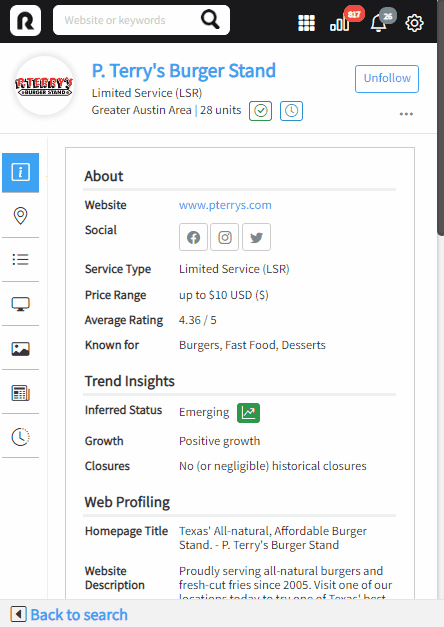Territory Insights
How Restaurantology defines and standardizes geographic insights to support sales coverage and TAM alignment.
Updated over a week ago
Understanding where a brand operates is as important as knowing how many units it has. Territory insights allow users to analyze and segment Concepts and Companies based on verified geographic presence, enabling smarter sales coverage design, TAM calculations, and market prioritization.
What are Territory insights?
Restaurantology defines Territory insights as the geographic dimensions applied to Concept and Company profiles, based on unit-level data aggregation. These insights provide clarity on where a brand operates and support territory mapping for sales, marketing, and RevOps teams.
Key geographic attributes include:
- State: Profiles can be filtered by either:
- MOST: Where 51% or more of a Concept’s or Company’s units operate.
- ANY: Any presence in the selected state(s).
- Urban Area: 274 U.S. and Canadian metroplexes where at least 51% of a profile’s units operate.
- Zip Code: Specific U.S. or Canadian ZIP/postal codes where any known unit presence exists (up to 5 ZIP codes per search).
- Custom Territory: User-defined areas drawn directly on a map, enabling dynamic, non-linear territory creation.
- Country: United States and Canada (current dataset scope).
How Territory insights are calculated
- Unit locations are verified and geocoded.
- Location data is rolled up to associated Concepts and Companies.
- Prevalence thresholds (51% or more) are used for “MOST” filters, while “ANY” filters reflect any verified presence.
[!NOTE]
Territory insights reflect verified data at the time of analysis. Restaurantology updates location mappings monthly but geographic presence can change as brands grow, shrink, or relocate units.
Why Territory insights matter
- Sales coverage: Supports territory design and assignment.
- TAM clarity: Ensures geographic boundaries align with strategic planning.
- Prospecting efficiency: Enables focused outreach within specific markets.
[!NOTE]
Restaurantology does not collect or display corporate headquarters (HQ) addresses. For smaller multi-unit groups, formal HQ locations are often nonexistent or not publicly available. Instead, Restaurantology uses prevalence-based geographic data to approximate a brand’s operational center. If 51% or more of a Concept’s or Company’s units are in a particular State or Urban Area, it is reasonable to assume that region functions as the group’s headquarters or primary market. This methodology scales consistently across both small and large brands, unlike HQ address data, which quickly becomes incomplete or unreliable beyond the largest chains.
Searching and filtering by territory
While this article explains how Restaurantology defines Territory insights, instructions for applying territory-based filters can be found in Browse using an advanced search →.
Example profile
A Restaurantology profile with Territory insights:

Next, continue to Points of Interest (POIs) →

